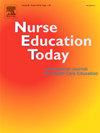AI-driven maternal and child healthcare nursing education: Network analysis of self-efficacy and usage demands
IF 4.2
2区 医学
Q1 EDUCATION, SCIENTIFIC DISCIPLINES
引用次数: 0
Abstract
Background
The application of artificial intelligence (AI) in maternal and child health nursing education is increasingly widespread, yet the dynamic relationship between nurses' AI self-efficacy and usage demands remains underexplored. In China's maternal and child health sector, nurses face high work pressure and training shortages, hindering AI integration. This study uses network analysis to uncover the complex structure of AI self-efficacy and demands among Chinese nurses, informing optimized AI training strategies.
Methods
A cross-sectional study employed convenience sampling of registered nurses (N = 848) from mainland China's maternal and child health institutions (January 1–March 1, 2025). The AI Self-Efficacy Scale (AISES; 22 items, 4 dimensions: assistance, anthropomorphic interaction, comfort, technical skills) assessed self-efficacy, with added questions on AI usage and training needs. LASSO-regularized partial correlation networks were built using R (qgraph package), characterizing key nodes via strength centrality, bridge strength, and predictability. Bootstrap methods verified network stability and edge accuracy.
Results
The network comprised 22 nodes and 122 non-zero edges (52.81 % of possible edges; mean weight = 0.0463). Highest influence: anthropomorphic interaction's AI_4 (“AI tone matches humans”; centrality = 2.654). Highest predictability: assistance's AS_3 (“AI aids learning effectively”; R2 = 0.905). Key bridge: AI_1 (“AI interaction vivid”; bridge strength = 3.403). Associate-degree nurses (N = 189) showed higher centrality in technical skills (TS_4, “AI jargon clear”; Δ = 0.429) and comfort (CF_5, “AI interaction relaxed”; Δ = 0.148) versus bachelor's-or-higher (N = 659). Only 13.7 % received AI training; 43.6 % had no exposure, underscoring deficiencies.
Conclusions
Network analysis highlights anthropomorphic interaction and learning assistance as core in AI self-efficacy, offering targets for targeted training. Suggestions include anthropomorphic training, AI resource platforms, terminology courses, low-stress exercises, and case studies to enhance AI integration, nursing quality, and maternal-infant outcomes. Cross-sectional limitations necessitate future longitudinal studies to validate effects and address grassroots needs.
人工智能驱动的妇幼保健护理教育:自我效能感与使用需求的网络分析
背景:人工智能(AI)在妇幼保健护理教育中的应用日益广泛,但护士人工智能自我效能感与使用需求之间的动态关系尚不清楚。在中国的妇幼保健领域,护士面临着高工作压力和培训短缺,阻碍了人工智能的整合。本研究通过网络分析揭示我国护士人工智能自我效能感和需求的复杂结构,为优化人工智能培训策略提供依据。方法:采用横断面研究方法,对2025年1月~ 3月1日中国大陆妇幼保健机构注册护士848名进行方便抽样。人工智能自我效能量表(AISES; 22个项目,4个维度:协助、拟人化互动、舒适度、技术技能)评估自我效能,并增加了关于人工智能使用和培训需求的问题。使用R (qgraph package)构建lasso正则化的部分相关网络,通过强度中心性、桥梁强度和可预测性来表征关键节点。Bootstrap方法验证了网络的稳定性和边缘精度。结果:网络由22个节点和122条非零边组成,占可能边的52.81%,平均权值为0.0463。影响最大:拟人化交互的AI_4(“AI音调与人类相匹配”,中心性= 2.654)。最高可预测性:辅助的AS_3(“AI有效地辅助学习”;R2 = 0.905)。关键桥架:AI_1(“AI交互逼真”,桥架强度= 3.403)。专科护士(N = 189)在技术技能(TS_4,“AI行话清晰”,Δ = 0.429)和舒适度(CF_5,“AI互动轻松”,Δ = 0.148)上的中心性高于本科及以上护士(N = 659)。只有13.7%的人接受过人工智能培训;43.6%的人没有暴露,强调了缺陷。结论:网络分析强调了人工智能自我效能感的拟人化互动和学习辅助是核心,为有针对性的训练提供了目标。建议包括拟人训练、人工智能资源平台、术语课程、低压力练习和案例研究等,以提高人工智能整合、护理质量和母婴结局。横向限制需要未来的纵向研究来验证效果和解决基层需求。
本文章由计算机程序翻译,如有差异,请以英文原文为准。
求助全文
约1分钟内获得全文
求助全文
来源期刊

Nurse Education Today
医学-护理
CiteScore
6.90
自引率
12.80%
发文量
349
审稿时长
58 days
期刊介绍:
Nurse Education Today is the leading international journal providing a forum for the publication of high quality original research, review and debate in the discussion of nursing, midwifery and interprofessional health care education, publishing papers which contribute to the advancement of educational theory and pedagogy that support the evidence-based practice for educationalists worldwide. The journal stimulates and values critical scholarly debate on issues that have strategic relevance for leaders of health care education.
The journal publishes the highest quality scholarly contributions reflecting the diversity of people, health and education systems worldwide, by publishing research that employs rigorous methodology as well as by publishing papers that highlight the theoretical underpinnings of education and systems globally. The journal will publish papers that show depth, rigour, originality and high standards of presentation, in particular, work that is original, analytical and constructively critical of both previous work and current initiatives.
Authors are invited to submit original research, systematic and scholarly reviews, and critical papers which will stimulate debate on research, policy, theory or philosophy of nursing and related health care education, and which will meet and develop the journal''s high academic and ethical standards.
 求助内容:
求助内容: 应助结果提醒方式:
应助结果提醒方式:


